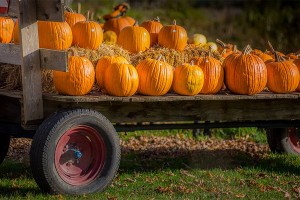What It’s Like to Be a Cranberry Farmer

Photo courtesey of A.D. Makepeace Company
Peak cranberry season in Massachusetts means harvest celebrations, bog tours, and an abundance of tart treats. But for Jeff LaFleur and other cranberry farmers in the state, October is a time of long work days and battles with Mother Nature.
LaFleur is the owner of Mayflower Cranberries in Plympton, where he balances the work of harvesting cranberries and running a business. Cranberry farmers like LaFleur have a lot on their plates (cranberries, mostly) and have to be ready for things to change on a dime.
“If you draw the analogy that the cranberry farm is a factory and we’re trying to produce widgets, the difference is that we don’t control our factory,” says LaFleur. “Mother Nature controls the factory. Which means we have to be prepared to deal with whatever Mother Nature throws at us on a given day or a given year.”
October is harvest season on cranberry farms, and it’s especially important to keep a watchful eye on cold temperatures. LaFleur explains that cranberry bogs are lower in elevation than surrounding landscapes, which means cold air becomes trapped in the bogs. Bogs are typically 10 to 15 degrees cooler than the areas around them, so if temperatures drop, measures need to be taken to make sure the berries don’t freeze.
LaFleur runs his irrigation system to pump water into the bogs in order to prevent the crops from being damaged by frost.
“It’s one of those things, once (freezing) happens, you’ve lost the crop for the year,” he says. “Mother Nature can take away everything you’ve worked on very quickly.”
LaFleur explains there’s no typical day on the farm, mainly because he’s always on call.
“My bog is out my bedroom window. I look at it every morning I wake up,” he says. “It’s a situation where we’re living right here on the farm and are immersed in everything relating to the farm on a daily basis.”
He could be clocking in at 2:30 a.m. to run the sprinklers before the frost settles in, (and then shutting them off at 8 a.m.) heading out to harvest fruit during the day, or managing the bookkeeping.
“One of the things I really like about cranberries is the fact that it is so variable on a day-to-day basis,” says LaFleur. “It changes constantly.”
Aside from helping quell cooler temps, cranberry bogs are filled with water as a harvest aid. The bogs are dry 90 percent of the year, and are flooded in the fall for harvest, as well as during the winter when the cold rolls in.
This week and weeks ahead are dedicated to harvesting. LaFleur divides the bog into sections, harvesting cranberries from a different section each day. He starts by putting on a pair of trusty rubber waders—those big, waterproof overalls you see in commercials—and physically removes the sprinkler heads that helped flood the bogs. He ensures the water level is high enough with flumes, and then loosens the fruit from the vines by swirling and churning the water with a water wheel. Once the cranberries are knocked off the vines, they’re corralled together and pumped out of the bog into a truck. Certain crops are harvested dry—these are fresh cranberries that are sold in grocery stores.
As a member of the Ocean Spray Cooperative, Mayflower Cranberries sends off their berries to be cleaned and then frozen, or made into juice or Craisins. In the off season, LaFleur goes “back to school” to learn about the latest, best, and sustainable production practices from university researchers. Winter is also the time for the company to work on its equipment, because cranberry harvest tools aren’t available to buy from farm suppliers—they have to be custom-made.
And, for the record, LaFleur asserts he never gets sick of eating cranberries.
“There are just so many different ways to enjoy cranberries,” he says, laughing. “It’s a regular staple in this household.”
Mayflower Cranberries offers tours for $10 by reservation during harvest season, 72 Brook St., Plympton, 718-585-1999, mayflowercranberries.com.


